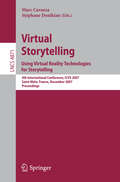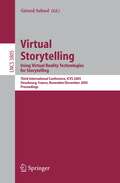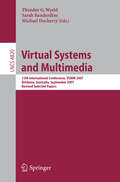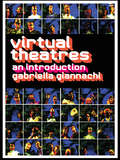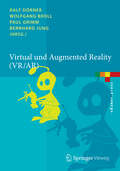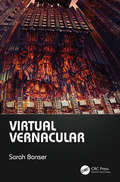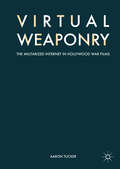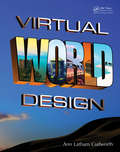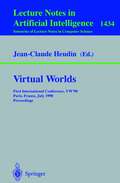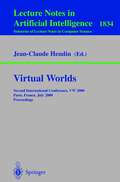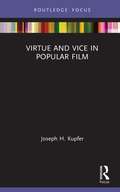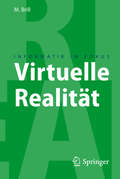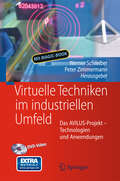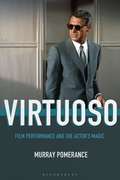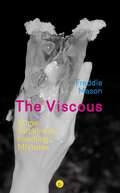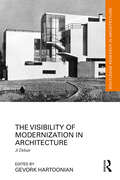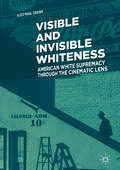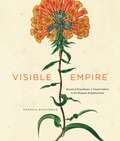- Table View
- List View
Virtual Storytelling. Using Virtual Reality Technologies for Storytelling: 4th International Conference, ICVS 2007, Saint-Malo, France, December 5-7, 2007, Proceedings (Lecture Notes in Computer Science #4871)
by Marc Cavazza Stéphane DonikianThis book constitutes the refereed proceedings of the 4th International Conference on Virtual Storytelling, ICVS 2007, held in Saint-Malo, France, in December 2007. The 12 revised full papers, three invited papers and seven poster and demo papers were carefully reviewed and selected. The papers are organized in topical sections on authoring tools and story models, behavior modeling, user interactivity, an invited session: related EU projects, as well as the poster and demo session.
Virtual Storytelling. Using Virtual Reality Technologies for Storytelling: Third International Conference, VS 2005, Strasbourg, France, November 30-December 2, 2005, Proceedings (Lecture Notes in Computer Science #3805)
by Gérard SubsolThe 1st International Conference on Virtual Storytelling took place on September 27–28, 2001, in Avignon (France) in the prestigious Popes’ Palace. Despite the tragic events of September 11 that led to some last-minute cancellations, nearly 100 people from 14 different countries attended the 4 invited lectures given by international experts, the 13 scientific talks and the 6 scientific demonstrations. Virtual Storytelling 2003 was held on November 20–21, 2003, in Toulouse (France) in the Modern and Contemporary Art Museum “Les Abattoirs.” One hundred people from 17 different countries attended the conference composed of 3 invited lectures, 16 scientific talks and 11 posters/demonstrations. Since autumn 2003, there has been strong collaboration between the two major virtual/digital storytelling conference series in Europe: Virtual Storytelling and TIDSE (Technologies for Interactive Digital Storytelling and Entertainment). Thus the conference chairs of TIDSE and Virtual Storytelling decided to establish a 2 year turnover for both conferences and to join the respective organizers in the committees. For the third edition of Virtual Storytelling, the Organization Committee chose to extend the conference to 3 days so that more research work and applications could be be presented, to renew the Scientific and Application Board, to open the conference to new research or artistic communities, and to call for the submission of full papers and no longer only abstracts so as to make a higher-level selection.
Virtual Systems and Multimedia: 13th International Conference, VSMM 2007, Brisbane, Australia, September 23-26, 2007, Revised Selected Papers (Lecture Notes in Computer Science #4820)
by Theodor G. Wyeld Sarah Kenderdine Michael DochertyThe 13th International Conference on Virtual Systems and Multimedia was held in Brisbane, Australia in September 2007. This was the first time that VSMM was sited in Australia. The Australian conference theme reflected the country’s cultural heritage, both recent and past – Exchange and Experience in Space and Place. Of the many papers submitted under this theme we were able to identify three core sub-themes: Virtual Heritage, Applied Technologies and Virtual Environments. With a truly international flavor, these sub-themes covered the diverse areas of heritage site and artifact reconstruction and analysis, Australian Aboriginal cultural heritage, training, notions of spirituality, human – computer interaction in virtual environments, 3D modelling, remote collaboration and virtual agents. This made for rich, varied and lively conference session debates. Ninety-seven papers were submitted. Of these, 56 were accepted for inclusion in the general conference proceedings. Of these, 18 were further reviewed and selected for this Springer publication. The authors of these papers were invited to revise their papers following feedback from the conference before inclusion in this volume. Many people contributed to the conference. We first wish to thank the Virtual Systems and Multimedia Society, who provided strong support to the whole process of the preparation of the conference. In particular, we would like to express our thanks to Takeo Ojika, Mario Santana Quintero and Hal Thwaites for their generous support and guidance.
Virtual Theatres: An Introduction
by Gabriella GiannachiThe first full-length book of its kind to offer an investigation of the interface between theatre, performance and digital arts, Virtual Theatres presents the theatre of the twenty-first century in which everything - even the viewer - can be simulated. In this fascinating volume, Gabriella Giannachi analyzes the aesthetic concerns of current computer-arts practices through discussion of a variety of artists and performers including: * blast Theory* Merce Cunningham* Eduardo Kac* forced entertainment* Lynn Hershman* Jodi Orlan* Guillermo Gómez-Peña* Marcel-lí Antúnez Roca* Jeffrey Shaw* Stelarc. Virtual Theatres not only allows for a reinterpretation of what is possible in the world of performance practice, but also demonstrates how 'virtuality' has come to represent a major parameter for our understanding and experience of contemporary art and life.
Virtual Theatres: An Introduction
by Gabriella GiannachiThe first full-length book of its kind to offer an investigation of the interface between theatre, performance and digital arts, Virtual Theatres presents the theatre of the twenty-first century in which everything - even the viewer - can be simulated. In this fascinating volume, Gabriella Giannachi analyzes the aesthetic concerns of current computer-arts practices through discussion of a variety of artists and performers including: * blast Theory* Merce Cunningham* Eduardo Kac* forced entertainment* Lynn Hershman* Jodi Orlan* Guillermo Gómez-Peña* Marcel-lí Antúnez Roca* Jeffrey Shaw* Stelarc. Virtual Theatres not only allows for a reinterpretation of what is possible in the world of performance practice, but also demonstrates how 'virtuality' has come to represent a major parameter for our understanding and experience of contemporary art and life.
Virtual und Augmented Reality: Grundlagen und Methoden der Virtuellen und Augmentierten Realität (eXamen.press)
by Ralf Dörner, Wolfgang Broll, Paul Grimm and Bernhard JungDas Lehrbuch vermittelt die theoretischen und praktischen Grundlagen, die benötigt werden, um Virtual- und Augmented-Reality-Systeme (VR/AR) eigenständig zu realisieren oder zu erweitern. Es dient Studierenden als anschauliche Begleitlektüre zu Lehrveranstaltungen, die VR/AR thematisieren, u. a. in den Fächern Informatik, Medien oder Natur- und Ingenieurwissenschaften. Durch seinen modularen Aufbau eignet sich der Band auch für das Selbststudium und kann darüber hinaus als Nachschlagewerk verwendet werden.
Virtual Vernacular
by Sarah BonserLearn to see the patterns and relationships in visual mediums and buildings as you push the boundaries of design. Sarah Bonser’s Virtual Vernacular breaks the barriers between architectural theory and game design. The text explores the way in which architecture can convey history, culture, and emotion to occupants, audience members, and players. Divided into three sections, the text guides the reader on how to tackle creative problem solving and development strategy. Key Features: Architectural theory is hard to navigate, and this approach is an accessible way to start learning it. Learn more specifically how pop culture parodies these design theories. Find ways to solve abstract design problems by using the built environment as a case study. Learn about technical limitations on the built environment that visually impact the look and feel of spaces. Each piece of architectural theory comes with abstracts and applications, which is a more organized and network-style way to teach an otherwise long-winded subject.
Virtual Vernacular
by Sarah BonserLearn to see the patterns and relationships in visual mediums and buildings as you push the boundaries of design. Sarah Bonser’s Virtual Vernacular breaks the barriers between architectural theory and game design. The text explores the way in which architecture can convey history, culture, and emotion to occupants, audience members, and players. Divided into three sections, the text guides the reader on how to tackle creative problem solving and development strategy. Key Features: Architectural theory is hard to navigate, and this approach is an accessible way to start learning it. Learn more specifically how pop culture parodies these design theories. Find ways to solve abstract design problems by using the built environment as a case study. Learn about technical limitations on the built environment that visually impact the look and feel of spaces. Each piece of architectural theory comes with abstracts and applications, which is a more organized and network-style way to teach an otherwise long-winded subject.
Virtual Weaponry: The Militarized Internet in Hollywood War Films
by Aaron TuckerThis book examines the convergent paths of the Internet and the American military, interweaving a history of the militarized Internet with analysis of a number of popular Hollywood movies in order to track how the introduction of the Internet into the war film has changed the genre, and how the movies often function as one part of the larger Military-Industrial- Media-Entertainment Network and the Total War Machine. The book catalogues and analyzes representations of a militarized Internet in popular Hollywood cinema, arguing that such illustrations of digitally networked technologies promotes an unhealthy transhumanism that weaponizes the relationships between the biological and technological aspects of that audience, while also hierarchically placing the “human” components at the top. Such filmmaking and movie-watching should be replaced with a critical posthumanism that challenges the relationships between the audience and their technologies, in addition to providing critical tools that can be applied to understanding and potentially resist modern warfare.
Virtual Weaponry: The Militarized Internet in Hollywood War Films
by Aaron TuckerThis book examines the convergent paths of the Internet and the American military, interweaving a history of the militarized Internet with analysis of a number of popular Hollywood movies in order to track how the introduction of the Internet into the war film has changed the genre, and how the movies often function as one part of the larger Military-Industrial- Media-Entertainment Network and the Total War Machine. The book catalogues and analyzes representations of a militarized Internet in popular Hollywood cinema, arguing that such illustrations of digitally networked technologies promotes an unhealthy transhumanism that weaponizes the relationships between the biological and technological aspects of that audience, while also hierarchically placing the “human” components at the top. Such filmmaking and movie-watching should be replaced with a critical posthumanism that challenges the relationships between the audience and their technologies, in addition to providing critical tools that can be applied to understanding and potentially resist modern warfare.
Virtual World Design
by Ann CudworthLearn How to Create Immersive Virtual EnvironmentsWritten by an award-winning designer with 20 years of experience designing virtual environments for television and online communities, Virtual World Design explores the intertwining disciplines of 2D graphics, 3D models, lighting, sound, and storytelling. It illustrates how these disciplines come to
Virtual Worlds: First International Conference, VW’98 Paris, France, July 1–3, 1998 Proceedings (Lecture Notes in Computer Science #1434)
by Jean-Claude Heudin1 Introduction Imagine a virtual world with digital creatures that looks like real life, sounds like real life, and even feels like real life. Imagine a virtual world not only with nice three dimensional graphics and animations, but also with realistic physical laws and forces. This virtual world could be familiar, reproducing some parts of our reality, or unfa miliar, with strange “physical” laws and artificial life forms. As a researcher interested in the sciences of complexity, the idea of a conference about virtual worlds emerged from frustration. In the last few years, there has been an increasing interest in the design of artificial environments using image synthesis and virtual reality. The emergence of industry standards such as VRML [1] is an illustra tion of this growing interest. At the same time, the field of Artificial Life has ad dressed and modeled complex phenomena such as self organization, reproduction, development, and evolution of artificial life like systems [2]. One of the most popular works in this field has been Tierra designed by Tom Ray: an environment producing synthetic organisms based on a computer metaphor of organic life in which CPU time is the “energy” resource and memory is the “material” resource [3]. Memory is or ganized into informational patterns that exploit CPU time for self replication. Muta tion generates new forms, and evolution proceeds by natural selection as different creatures compete for CPU time and memory space.
Virtual Worlds: Second International Conference, VW 2000 Paris, France, July 5-7, 2000 Proceedings (Lecture Notes in Computer Science #1834)
by Jean-Claude HeudinVirtual Worlds 2000 is the second in a series of international scientific conferences on virtual worlds held at the International Institute of Multimedia in Paris La Défense (Pôle Universitaire Léonard de Vinci). The term "virtual worlds" generally refers to virtual reality applications or experi ences. We extend the use of these terms to describe experiments that deal with the idea of synthesizing digital worlds on computers. Thus, virtual worlds could be de fined as the study of computer programs that implement digital worlds. Constructing such complex artificial worlds seems to be extremely difficult to do in any sort of complete and realistic manner. Such a new discipline must benefit from a large amount of work in various fields: virtual reality and advanced computer graphics, artificial life and evolutionary computation, simulation of physical systems, and more. Whereas virtual reality has largely concerned itself with the design of 3D immersive graphical spaces, and artificial life with the simulation of living organisms, the field of virtual worlds, is concerned with the synthesis of digital universes considered as wholes, with their own "physical" and "biological" laws.
Virtue and Vice in Popular Film (Routledge Focus on Film Studies)
by Joseph H. KupferThis book addresses a prominent group of virtues and vices as portrayed in popular films to further our understanding of these moral character traits. The discussions emphasize the interplay between the philosophical conception of the virtues and vices and the cinematic representations of character. Joseph H. Kupfer explores how fictional characters possessing certain moral strengths and weaknesses concretize our abstract understanding of them. Because the actions that flow from these traits occur in cinematic contexts mirroring real world conditions, the narrative portrayals of these moral characteristics can further our appreciation of their import. Humility, integrity, and perseverance, for example, are depicted in Chariots of Fire, The Fabulous Baker Boys, and Billy Elliot, while the vices of envy, arrogance and vanity are captured in Amadeus, Whiplash, and Young Adult. This interdisciplinary work in philosophy and film criticism will be of great interest to scholars and students of film studies, philosophy of film, ethics, aesthetics, and popular culture.
Virtue and Vice in Popular Film (Routledge Focus on Film Studies)
by Joseph H. KupferThis book addresses a prominent group of virtues and vices as portrayed in popular films to further our understanding of these moral character traits. The discussions emphasize the interplay between the philosophical conception of the virtues and vices and the cinematic representations of character. Joseph H. Kupfer explores how fictional characters possessing certain moral strengths and weaknesses concretize our abstract understanding of them. Because the actions that flow from these traits occur in cinematic contexts mirroring real world conditions, the narrative portrayals of these moral characteristics can further our appreciation of their import. Humility, integrity, and perseverance, for example, are depicted in Chariots of Fire, The Fabulous Baker Boys, and Billy Elliot, while the vices of envy, arrogance and vanity are captured in Amadeus, Whiplash, and Young Adult. This interdisciplinary work in philosophy and film criticism will be of great interest to scholars and students of film studies, philosophy of film, ethics, aesthetics, and popular culture.
Virtuelle Realität (Informatik im Fokus)
by Manfred BrillVirtuelle Realität oder Virtual Reality (VR) hat in den letzten Jahren eine stürmische Entwicklung genommen. Dieses Buch führt in Theorie und Praxis der virtuellen Realität ein und liefert einen Überblick über Software-Architekturen. Der Schwerpunkt liegt bei Anwendungen der VR, beispielhafte Anwendungen werden mit VR Juggler betrachtet und implementiert. Für das erfolgreiche Bearbeiten der Aufgaben sind Erfahrungen im Programmieren mit C++ und OpenGL erforderlich, Kenntnisse in Computergrafik und Grafikprogrammierung werden vorausgesetzt.
Virtuelle Techniken im industriellen Umfeld: Das AVILUS-Projekt - Technologien und Anwendungen
by Werner Schreiber Peter ZimmermannIn dem Buch betrachten Experten den Einsatz virtueller Technologien über den gesamten Lebenszyklus eines Produkts hinweg – von der Entstehung bis zum End of Produktion (EOP). Dargestellt werden Konzepte zur Informationsbereitstellung im Product Life Cycle Management, Simulation und Rendering, Lokalisation und Tracking sowie weitere Fragen zur virtuellen und erweiterten Realität. Die Ergebnisse des AVILUS-Projekts zeigen, dass diese Technologien in kleinen und mittleren Unternehmen zur Steigerung von Wirtschaftlichkeit und Qualität beitragen können.
Virtuoso: Film Performance and the Actor's Magic
by Murray PomeranceElizabeth Taylor's electrifying performance in Who's Afraid of Virginia Woolf? The milkshake scene in There Will be Blood. Leonardo DiCaprio's turn as Arnie in What's Eating Gilbert Grape? What makes these performances so special? Eloquently written and engagingly laid out, Murray Pomerance answers the tough question as to what makes an exceptional, or virtuosic performance. Pomerance intensively explores virtuosic performance in film, ranging from classical works through to contemporary production, and gives serious consideration to structural problems of dramatization and production, actorial methods and tricks, and contingencies that befall performers giving stand-out moments.Looking at more than 40 aspects of the virtuosic act, and using an approach based in careful meditation and discursion, Virtuoso moves through such themes as showing off, effacement, self-consciousness, performative collapse, spontaneity, acting as dream, acting and femininity, virtuosity and torture, secrecy, improvisation, virtuosic silence, and others; giving special attention to the labors of such figures as Fred Astaire, Johnny Depp, Marlene Dietrich, Basil Rathbone, Christopher Plummer, Leonardo DiCaprio, Alice Brady, Ethel Waters, James Mason, and dozens more. Numerous scenic virtuosities are examined in depth, from films as far-ranging as Singin' in the Rain and The Bridge on the River Kwai, and My Man Godfrey. As the first book about virtuosity in film performance, Virtuoso offers exciting new angles from which to view film both classical and contemporary.
Virtuoso: Film Performance and the Actor's Magic
by Murray PomeranceElizabeth Taylor's electrifying performance in Who's Afraid of Virginia Woolf? The milkshake scene in There Will be Blood. Leonardo DiCaprio's turn as Arnie in What's Eating Gilbert Grape? What makes these performances so special? Eloquently written and engagingly laid out, Murray Pomerance answers the tough question as to what makes an exceptional, or virtuosic performance. Pomerance intensively explores virtuosic performance in film, ranging from classical works through to contemporary production, and gives serious consideration to structural problems of dramatization and production, actorial methods and tricks, and contingencies that befall performers giving stand-out moments.Looking at more than 40 aspects of the virtuosic act, and using an approach based in careful meditation and discursion, Virtuoso moves through such themes as showing off, effacement, self-consciousness, performative collapse, spontaneity, acting as dream, acting and femininity, virtuosity and torture, secrecy, improvisation, virtuosic silence, and others; giving special attention to the labors of such figures as Fred Astaire, Johnny Depp, Marlene Dietrich, Basil Rathbone, Christopher Plummer, Leonardo DiCaprio, Alice Brady, Ethel Waters, James Mason, and dozens more. Numerous scenic virtuosities are examined in depth, from films as far-ranging as Singin' in the Rain and The Bridge on the River Kwai, and My Man Godfrey. As the first book about virtuosity in film performance, Virtuoso offers exciting new angles from which to view film both classical and contemporary.
The Viscous: Slime, Stickiness, Fondling, Mixtures
by Freddie MasonSlime, goo, gunge, gloop, gels, sols, globules, jellies, emulsions, greases, soaps, syrups, glues, lubricants, liquid crystals, moulds, plasmas, and protoplasms – the viscous is not one thing, but rather a quality of resistance and flow, of stickiness and slipperiness. It is a state of matter that oozes into the gaps of our everyday existence, across age groups, between cultures and disciplines.Since the large-scale extraction of petroleum in the 19th century, the viscous has witnessed a proliferation in the variety of its forms. Mechanized industry required lubricants and oil distillation produced waste products that were refined to form Vaseline. From this age, new viscous forms and technologies emerged: products from plastic (and plastic explosives) to cosmetics, glycerine, asphalt, sexual lubrication, hydro- and aero-gels, and even anti-climb paint.Based on unique and wide-ranging research, The Viscous is the first major investigation of encounters with and possibilities of the viscous over the course of the last century, not simply as a material state, but also as an imaginative event. We enter into a story of matter at its most wayward, deviant, hesitant, and resistant.From asphalt lakes to industrial molasses tanks, from liquid crystals squirming in our screens to milk fetishes, The Viscous discloses gooeyness as a peculiarly modern phase of matter. "Everything oozes," as Beckett’s Estragon famously proclaims in Waiting for Godot. Viscous dynamics are exposed as not only hugely various in a post-industrial age, but particularly useful ways of thinking, feeling, writing, and making in a time of ecological anxiety.
The Visibility of Modernization in Architecture: A Debate (Routledge Research in Architecture)
by Gevork HartoonianThis edited collection explores the visibility of modernization in architecture produced in different capitalist regions across the world and provides readers with a historico-theoretical and historico-geographical discussion. Focusing on a particular building type, an influential architect’s work, as well as relevant texts and documents, each chapter addresses the many facets of "delay" which are central to the problematization of capitalism’s progressive dissemination of technological and aesthetic regimes of modernism. This collection underlines the centrality of temporality for a critical understanding of colonialism, modernism, and capitalism. The book is primarily concerned with the historical timeline, the tangential point when a nation enters modernization processes. In exploring modernism in diverse regions such as East Asia, Pacific, Eastern Europe, and Iran, each chapter addresses the historiographic and architectonic unfolding of modernization beyond the western hemisphere. The exploration of these diverse case-studies will be of interest to students of architecture and researchers working on the collision of temporalities and the subject's critical importance for different country’s built-environments.
The Visibility of Modernization in Architecture: A Debate (Routledge Research in Architecture)
by Gevork HartoonianThis edited collection explores the visibility of modernization in architecture produced in different capitalist regions across the world and provides readers with a historico-theoretical and historico-geographical discussion. Focusing on a particular building type, an influential architect’s work, as well as relevant texts and documents, each chapter addresses the many facets of "delay" which are central to the problematization of capitalism’s progressive dissemination of technological and aesthetic regimes of modernism. This collection underlines the centrality of temporality for a critical understanding of colonialism, modernism, and capitalism. The book is primarily concerned with the historical timeline, the tangential point when a nation enters modernization processes. In exploring modernism in diverse regions such as East Asia, Pacific, Eastern Europe, and Iran, each chapter addresses the historiographic and architectonic unfolding of modernization beyond the western hemisphere. The exploration of these diverse case-studies will be of interest to students of architecture and researchers working on the collision of temporalities and the subject's critical importance for different country’s built-environments.
Visible and Invisible Whiteness: American White Supremacy through the Cinematic Lens
by Alice Mikal CravenVisible and Invisible Whiteness examines the complicity between Classical Hollywood narratives or genres and representations of white supremacy in the cinema. Close readings of D.W. Griffith’s The Birth of a Nation by James Agee and James Baldwin explore these authors’ perspectives on the American mythologies which ground Griffith’s film. The intersectionality of Bordwell’s theories on Classical Hollywood Narrative versus Art Cinema and Richard Dyer’s seminal work on whiteness forms the theoretical base for the book. Featured films are those which have been undervalued or banned due to their hybrid natures with respect to Hollywood and Art Cinema techniques, such as Samuel Fuller’s White Dog and Jean Renoir’s The Southerner. The book offers comparative analyses of American studio-based directors as well as European and European émigrés directors. It appeals to scholars of Film Theory, African American and Whiteness Studies. It provides insight for readers concerned about the re-emergence of white supremacist tensions in contemporary America.
Visible and Invisible Whiteness: American White Supremacy through the Cinematic Lens
by Alice Mikal CravenVisible and Invisible Whiteness examines the complicity between Classical Hollywood narratives or genres and representations of white supremacy in the cinema. Close readings of D.W. Griffith’s The Birth of a Nation by James Agee and James Baldwin explore these authors’ perspectives on the American mythologies which ground Griffith’s film. The intersectionality of Bordwell’s theories on Classical Hollywood Narrative versus Art Cinema and Richard Dyer’s seminal work on whiteness forms the theoretical base for the book. Featured films are those which have been undervalued or banned due to their hybrid natures with respect to Hollywood and Art Cinema techniques, such as Samuel Fuller’s White Dog and Jean Renoir’s The Southerner. The book offers comparative analyses of American studio-based directors as well as European and European émigrés directors. It appeals to scholars of Film Theory, African American and Whiteness Studies. It provides insight for readers concerned about the re-emergence of white supremacist tensions in contemporary America.
Visible Empire: Botanical Expeditions and Visual Culture in the Hispanic Enlightenment
by Daniela BleichmarBetween 1777 and 1816, botanical expeditions crisscrossed the vast Spanish empire in an ambitious project to survey the flora of much of the Americas, the Caribbean, and the Philippines. While these voyages produced written texts and compiled collections of specimens, they dedicated an overwhelming proportion of their resources and energy to the creation of visual materials. European and American naturalists and artists collaborated to manufacture a staggering total of more than 12,000 botanical illustrations. Yet these images have remained largely overlooked—until now. In this lavishly illustrated volume, Daniela Bleichmar gives this archive its due, finding in these botanical images a window into the worlds of Enlightenment science, visual culture, and empire. Through innovative interdisciplinary scholarship that bridges the histories of science, visual culture, and the Hispanic world, Bleichmar uses these images to trace two related histories: the little-known history of scientific expeditions in the Hispanic Enlightenment and the history of visual evidence in both science and administration in the early modern Spanish empire. As Bleichmar shows, in the Spanish empire visual epistemology operated not only in scientific contexts but also as part of an imperial apparatus that had a long-established tradition of deploying visual evidence for administrative purposes.
